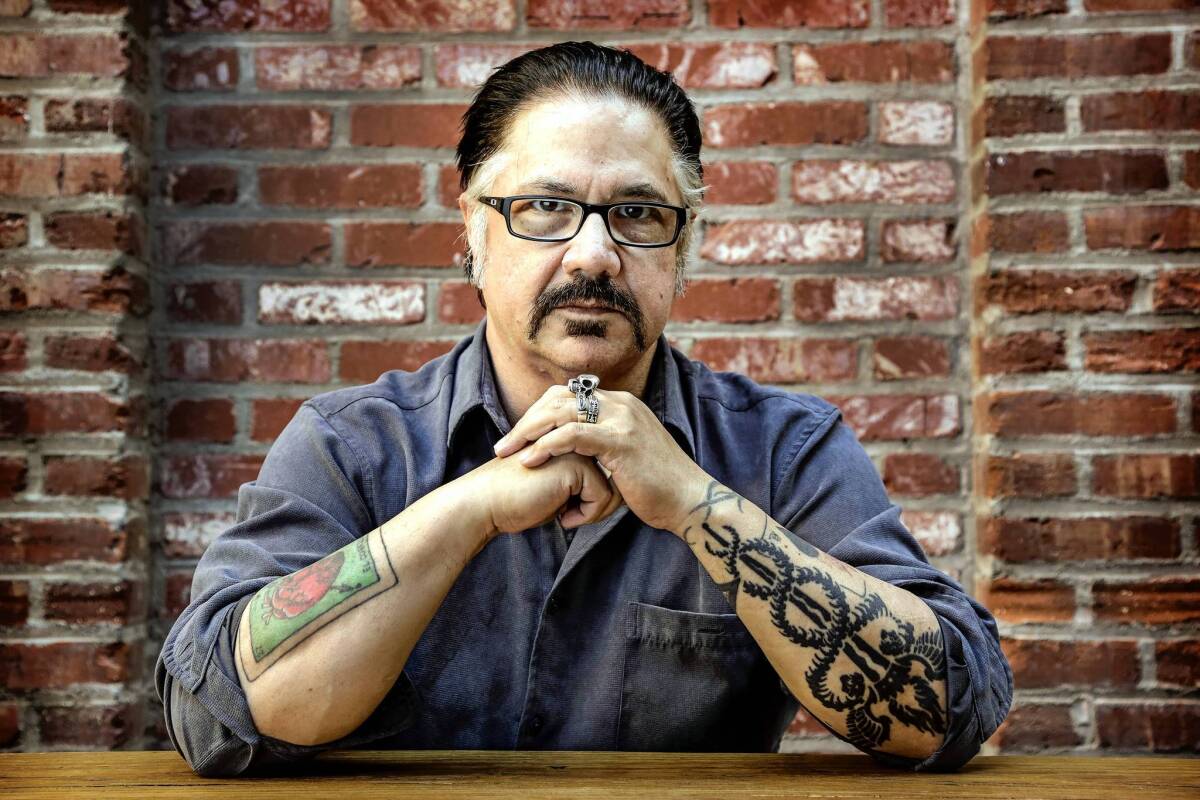Richard Kadrey takes on teen horror in ‘Dead Set’

Richard Kadrey’s new novel, “Dead Set,” gave me nightmares. And I can’t stop myself from telling him — even though the bestselling horror author dresses in black, has intimidating tattoos and the watchful bearing of an assassin. He’s reluctant to take off his dark glasses.
“Cool,” he says, stirring his coffee in the dim daytime light of a Los Angeles bar. “It’s an experiment.” “Dead Set” (Harper Voyager, $22.99) is far less violent than the bestselling Sandman Slim series he’s known for: “There’s fewer bad words and less actual bloody body parts.”
The noir-meets-urban-fantasy Sandman Slim series — five books so far — feature a wry criminal hero from Hell who has the occasional existential crisis, plus a supporting cast of demons, strippers, zombies, ghouls and demi-gods, all doused in dark magic and brain-splattering brutality.
Bookshelf: Sign up for our email newsletter
“Dead Set” is a major departure: It’s for young adults and omits the dirtiest, darkest elements of Kadrey’s oeuvre. Characters still travel to the underworld, but where Slim is brutal and sexual, “Dead Set” focuses on longing and the pull of the past.
In preparation for writing for young adults, Kadrey read works by Neil Gaiman and Holly Black. Black’s 2002 YA novel, “Tithe,” he says, “really impressed me with how far you could go, how hard you could be, the kind of families and kids you could talk about.”
The protagonist of “Dead Set” is Zoe, a teenager who’s moved into a cheap San Francisco apartment with her mom after her dad’s death. Zoe discovers a used-record store with a passage to purgatory and bargains with its double-dealing owner to reach her father.
“A lot of the characters I’ve written about are people with power. I wanted to write about someone with virtually no power,” Kadrey says. “There’s nothing worse than being 16 — you have all these adult responsibilities, no actual adult power.”
As a teenager in Houston in the 1970s, Kadrey felt that frustration. He got good grades but resisted the sit-still-and-do-as-you’re-told aspect of school. “Everyone asks how I could write about a teenage girl,” he says. “Well, the part that was me was Zoe thinking she was way smarter than anybody else.”
Like Zoe, Kadrey lost his dad (when he was 3) and was brought up by a mother who sometimes struggled financially. She encouraged her son’s writing; he began publishing music and concert reviews in local papers when he was just 15.
“One of my big regrets is that she died before I made the New York Times bestseller list. That would have made her happy,” he says.
Kadrey didn’t find success as a novelist until “Sandman Slim” was published in 2009. Although he’d always thought of himself as a writer, his focus had drifted. As a young man, he’d driven a forklift in a warehouse; later, in San Francisco, he detoured from writing for Wired to taking a full-time job at an ad agency in the first dot-com boom. “At the ad agency, I was a writer. Just not necessarily what I wanted to write,” he says.
When the Internet economy went bust, Kadrey was bereft — but the low he experienced helped him find his voice.
Although he has lived in San Francisco for decades, Kadrey spent most of his 20s in Silverlake — chic now, but dingy and crime-ridden in the early 1980s. He rode the bus to work, at a bookstore in the Bonaventure, and saw more bands play than he can remember — mostly because of the Jack Daniels he was drinking. “It was brutal, because none of my writing was any good back then. It was very hard.”
The texture of those difficult years inform the Sandman Slim novels, which are set in L.A. “I love L.A.,” Kadrey says. “I love L.A. for all the reasons other people hate L.A. It’s venal, and it’s hierarchical.”
He cheerily talks about meeting with the producers from the De Laurentiis company, which has optioned Sandman Slim. “There’s that great L.A. look: Are you someone I should know, someone I should be nice to? After a few minutes they go, ‘Nah.’ And you can see their eyes wander off.”
Kadrey has often set Slim up to wreak havoc on filmland. In “Kill City Blues,” published in July, his characters camped out in the apex of Hollywood, the penthouse of the Chateau Marmont.
Urban fantasies are set in cities and incorporate real elements — hotels, doughnut shops — to which Kadrey has added the intense unsentimentality of noir. Inspired by the books of Jim Thomson and Donald Westlake (Slim’s real name is James Stark in his honor), Kadrey wanted to write fantasy stories from the point of view of the criminal.
The Sandman Slim universe incorporates elements of Christianity, the Kabbalah, and the Gnostic Gospels. Its Los Angeles is inhabited by a parallel population of monsters, some familiar, some invented. “I’m on the side of the monsters,” Kadrey says, referencing something Guillermo del Toro said about “Pan’s Labrynth”: “You kind of have to be on the side of the monsters to live with the monsters.”
Each book in the series incorporates a different sub-genre. In “Kill City Blues,” it’s the haunted house — via the Gothic. “If you’re a Gothic lit major, you will find these little tropes. To really nail down my credentials, there’s even a Castle of Otranto joke,” Kadrey says, referring to the 1764 book by Horace Walpole, considered the first Gothic novel.
Kadrey has heard from a couple of fans who got it. He’s entirely comfortable engaging with his readers online, on Twitter and in Reddit Ask Me Anything interviews. He’s also active on Tumblr, where his blog often includes his sideline, not-safe-for-work fetish photography.
Kadrey was able to set that sensibility aside, however, in “Dead Set.” Leaving the sexuality, violence and extreme language of Sandman Slim behind may be frightening for a writer as gorily successful as Kadrey, but it was a risk that pays off. “Dead Set” is a tender, if terrifying, story of a lost teenager trying to find her way.
More to Read
Sign up for our Book Club newsletter
Get the latest news, events and more from the Los Angeles Times Book Club, and help us get L.A. reading and talking.
You may occasionally receive promotional content from the Los Angeles Times.









